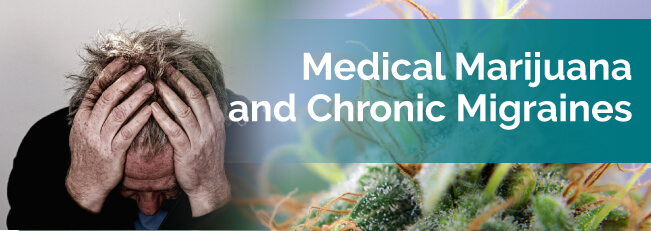
Medical marijuana has been found by many patients to prevent or lessen the intolerable pain and other symptoms of migraines. While common over-the-counter medications may not work, cannabis can provide quick relief of debilitating symptoms. Now that medical cannabis is legal in most states, some patients might turn to the soothing qualities of medical marijuana for migraine treatment.

For example, according to the journal Cannabis and Cannabinoid Research, many patients currently use marijuana to relieve migraine pain. In a survey of nine California clinics, over 40 percent of patients reported benefits for migraines and headaches using marijuana. In another California study, over 8 percent of patients reported using cannabis to relieve migraine symptoms.
Additionally, recent research has shown that tetrahydrocannabinol (THC), the main chemical component in marijuana, can help alleviate pain, nausea and vomiting associated with migraine headaches. THC can also inhibit the release of serotonin during an acute migraine attack, which reduces symptoms of pain.
In this article, you’ll learn more about migraines, the symptoms of migraines, how medical marijuana can alleviate symptoms and how to use medical cannabis for fast relief.
The majority of U.S. states allow the medical use of pot. Some states, including California and Connecticut, approve medical cannabis for migraine treatment.
Although marijuana for migraines has been used for many years, it’s only recently that scientists have figured out why it’s effective. One study looked at the effects of both ingested and inhaled weed in migraine sufferers and confirmed what other research suggests. The study found:
Smoking or inhaling cannabis provided migraine sufferers with the fastest relief, but also reduced the number of migraines experienced. For the five million people in the U.S. who have at least one migraine each month, this result could change their life.
Cannabinoids are the natural compounds found in marijuana. When you use cannabis, these cannabinoids enter your body looking for the cannabinoid receptors located in your endocannabinoid system. They affect how your receptors work and calm down the pain signals. As a result, cannabinoids help with:
Although migraine sufferers use different types of weed, they mostly inhale it to halt a migraine in progress. Edible marijuana products, while effective, take longer to work, which is why most patients prefer to smoke medical cannabis. Smoking medical marijuana also allows you to control how much of the medicine you receive.
The first step to obtaining medical marijuana for migraines is to research the cannabis laws in your state. You’ll need to know if medical marijuana is legal in your state, and you’ll also need to check what conditions qualify for medical cannabis in your state.
If medical marijuana is legal in your state, the next step you’ll want to take is to locate a doctor who is qualified to recommend medical cannabis. Depending on where you live, you may need to visit the doctor in their office, or you may be able to receive a cannabis recommendation through a video consultation.
If migraines fall on the list of qualifying conditions within your state, a certified cannabis doctor may write a recommendation for you. You may also need to apply for a medical marijuana card which shows you are using marijuana for medicinal purposes. Once you have the recommendation and your marijuana card, you can obtain medical marijuana from a dispensary to use for migraine treatment.
Many ways exist for taking medical marijuana for migraines. Some experts believe that smoking a joint or using a vaporizer is best because the medicine works faster. You need to observe how you feel after you take cannabis in this way. Determine if you feel better, worse or about the same — and then adjust your dosage accordingly. Whether you smoke, vape or eat your cannabis, it’s essential to start slowly. If you take too much, you could increase the chance of another headache.
Here are a few ways you can use medical cannabis for migraines, and some of the pros and cons of each approach:
Your state’s medical marijuana laws may limit how you can use medical weed. Some states, for example, don’t allow smoking, even though it’s an effective method for migraines because of the quick onset. Read up on your state’s laws beforehand or speak with your doctor about the best method of administration for you.
Certain strains of weed tend to work better than others when it comes to helping relieve migraine symptoms. For example, a strain known as Girl Scout Cookies is preferred by many smokers, whether they are just starting out or have smoked medicinal weed for a long time. Users typically say that it has a sweet scent and provides a euphoric, relaxing feeling.
Sour Diesel is another popular strain. It’s been around since the early 1990s. Also called “Sour D,” it gets its name from its pungent aroma that many liken to diesel fuel. It delivers a dreamy, energizing high as well as long-lasting relief from pain.
Other strains that help for the symptoms of migraines include:
Medical marijuana doctors can often recommend a blend that will help with your specific symptoms. If you cope with nausea and lightheadedness, for example, they may suggest a medical marijuana strain with fewer psychoactive effects.
Side effects of smoking cannabis include:
Some of these side effects, like paranoia or anxiety, are caused by strains with high amounts of THC, which creates a psychoactive response. Many physicians recommend medical marijuana with small THC amounts to reduce these symptoms. Overall, patients find the benefits of medical cannabis outweigh its potential side effects.
In a review published in the journal Frontiers in Pharmacology, researchers evaluated new discoveries regarding the role of cannabinoids in reducing migraine pain. As a result of their analysis, the researchers concluded that cannabinoids, due to their anti-inflammatory, anticonvulsive, pain-relieving and nausea-relieving effects, seem promising as a migraine treatment.
Migraines are the third most prevalent condition worldwide, yet are still difficult to treat. If you’re experiencing sensitivity to noise or light, pain or nausea, and traditional medicine isn’t helping you, marijuana may be an effective option. Medical marijuana is a proven treatment for relieving migraines and may even help prevent future headaches from starting.

Migraine headaches afflict 28 million Americans, yet they remain under-treated and under-diagnosed. Less than half the sufferers are diagnosed by their doctors. Migraine headaches can be extremely severe and debilitating and can cause significant pain and other side effects for hours or even days.
People often describe their severe headache as a “migraine.” However, a migraine headache comes on due to specific physiologic changes that happen in your brain, which causes the pain and other symptoms of migraines.
A migraine headache causes sensitivity to light, sound and smells. You may even experience nausea or vomiting. With migraines, the pain you feel usually involves one side of your head. Some people feel the pain on both sides in the form of pounding or throbbing. Physical exertion tends to make the pain worse.
People experience several different types of migraines. Knowing which kind you’re experiencing makes it easier to treat them and prevent future attacks.
The two main types of migraines are:
This migraine is the most prevalent. You experience moderate to severe one-sided headache pain that pulsates. You’ll also have one or more of the following symptoms:
Migraines without aura tend to last four to 72 hours. You may get this headache a few times per year. If you have migraines without auras often, you may have chronic headaches.
Once called a classic migraine, a migraine with aura causes visual disturbances and neurological symptoms before your headache starts. Visual disturbances include flashing lights, blind spots, zig-zag and wavy lines, which can last for 10 minutes to more than one hour.
Several, lesser known, migraines also exist. Below are six kinds that you may not be familiar with:
You may know about the noise and light sensitivity, nausea, vomiting and throbbing pain that comes with migraine headaches, but up to 60 percent of migraine sufferers also have intense dizziness and sensitivity to motion. Twenty percent of migraine sufferers experience severe vertigo that could result in fainting episodes. These are vestibular migraines.
You can distinguish a retinal migraine from other headaches if you have repeated episodes of visual disturbance in one eye. Blindness, blind spots or sparkles and flashes of light are also symptoms. Fortunately, these symptoms are typically temporary, cause little pain and last for around 30 minutes.
A migraine with brainstem aura (MBA) creates an aura and one or more of these reversible symptoms:
You may also experience a decreased level of consciousness.
An abdominal migraine is a common condition in adolescents and children. It also often serves as a sign that they’ll start developing migraines. These headaches involve repeated bouts of severe nausea and vomiting. While experiencing an abdominal migraine, you may also feel pain near your midline or navel.
Because abdominal migraines don’t create a headache and aren’t a leading cause of stomach pain, they’re difficult to diagnose. To diagnose these migraines, many physicians look at your family history, as about 90 percent of patients with migraines have a family history of them.
Along with the cramps and mood swings you experience during your period, you may also have menstrual migraines. However, fewer than 20 percent of women get migraines during their menstrual cycle. They may experience headaches at other times during the month, but it’s around their period that their migraines worsen due to hormone fluctuations.
A true menstrual migraine only occurs during your menstrual cycle and often happens one day into your cycle or two days before your period starts. If you have headaches at least two out of every three cycles each year, it’s likely a menstrual migraine.
When you have a hemiplegic migraine, you often experience motor weakness that’s not always reversible. For instance, partial body paralysis may accompany your migraines but last longer than your headache. Hemiplegic migraines are more common in children and infants than adults. They’re also hard to diagnose due to their complexity.
As studies continue to examine migraines and the science behind them, it’s possible more types of chronic headaches will be discovered and treated with alternative medicine, like medical marijuana.
A migraine is caused by abnormal brain activity which may be triggered by a certain event. Scientists are not sure of the exact chain of events that lead to a migraine, however, they believe a migraine attack starts in the brain and involves nerve pathways and chemicals. Nerves may become overstimulated and cause blood vessels to dilate. This affects blood flow in the brain and surrounding tissues, which can lead to a range of symptoms. A migraine attack may be brought on by any of the following:
Migraines are among the oldest known conditions. The ancient Egyptians reported the earliest cases of painful headaches back in 1200 B.C. An initial description, written in ancient Egypt around 1500 B.C. on papyrus, was consistent with migraine symptoms.
Hippocrates, later in approximately 400 B.C., referred to the visual disturbances that come before a migraine headache, such as blurred vision and flashing lights. He also described how sufferers felt relief after vomiting. Hippocrates’ notes were later reiterated in 200 B.C.
The credit of migraine discovery goes to Aretaeus of Cappadocia. He described the unilateral or one-sided headaches in the second century that are characteristic of migraines, as well as the vomiting that accompanies chronic headaches and the symptom-free periods between attacks.
His second-century description classified headaches by separating them into three categories:
The word migraine comes from the term hemicrania, meaning half-head. Galen of Pergamum used the term to describe this type of headache pain. He suggested that the discomfort from migraines came from the meninges and blood vessels in the head.
In the 17th century, aggressive treatments for migraines were developed. William Harvey, a physician, suggested trepanation, or drilling a hole in the skull, as a migraine treatment. The procedure was believed to let evil spirits escape. History shows, however, that Harvey wasn’t the first to suggest the practice. In fact, as early as 7000 B.C., people were practicing trepanation. Other important moments in the early history of migraine research include:
Most of the research used today is based on the work of Paul Ehrlich, who won a Nobel Prize in Physiology or Medicine in 1908 for his contributions to immunology.
Migraines tend to start during childhood or early adulthood. They often progress through four stages which include:
You might not experience all four of these stages. A couple of days before you get a migraine though, you might experience subtle warning signs. These symptoms include:
Some migraines are accompanied by extreme sensitivity to sound and light as well as nausea and vomiting. Some people get a warning “sign” that a migraine is imminent. They receive an aura or visual sign that comes in the form of a blind spot, flashes of light or tingling in the leg or arm. Auras can sometimes be sensory, verbal or motor disturbances. You might feel like someone is touching you, for example, or that your muscles are weak.
These symptoms tend to come on gradually, build up over a few minutes and last anywhere from 10 to 60 minutes. Migraine aura examples include:
Migraines typically last from four to 72 hours if left untreated. Each person differs in the frequency of their headaches, as well as how often they occur. Around 1.7 to 4 percent of Americans, for example, have migraines 15 or more days each month, while 5 million Americans have at least one migraine a month.

Symptoms of a migraine include:
Post-drome is the final stage of a migraine and happens after an attack. It can leave you feeling drained or relieved. Patients may experience:

Because of the debilitating symptoms of migraines, they can be a financial burden for migraine sufferers. Healthcare and productivity costs from migraines are estimated at $36 billion in the U.S., while the cost of treating chronic headaches alone is more than $5.4 billion. Most patients with migraines — more than 90 percent — are also unable to work when having an attack.
Treatments for acute migraines may vary from prescription drugs to over-the-counter medications like:
Triptans are also used for migraine relief and include:
Triptans can be quite effective in treating migraines and helping patients recover at home. Now available as a combination of sumatriptan and naproxen, you can also get sumatriptan as a patch.
Side effects of triptans may include:
Some medications are ideal for home use, while others require you to visit the emergency department or your doctor’s office. Traveling to the doctor or emergency room during an attack, however, is difficult for patients without someone to accompany them.
Other available treatments for migraines include:
Many doctors recommend tracking how often your migraines occur by using a digital headache diary to log your triggers, pain levels and symptoms. By doing this, you can help identify any potential patterns that come before your migraine and identify factors that could be contributing to the development of your migraines. These factors can help both you and your doctor develop a treatment plan.
Across the country, states are making it possible for the millions of Americans who suffer from severe migraines to access medical weed. If you cope with chronic headaches and traditional treatments aren’t helping you, consider medical marijuana.
To learn more about cannabis for migraines, and get your ideal strain, search for a medical marijuana dispensary or doctor today. You don’t have to live with the pain of migraines.
Find A Doctor Find A Dispensary